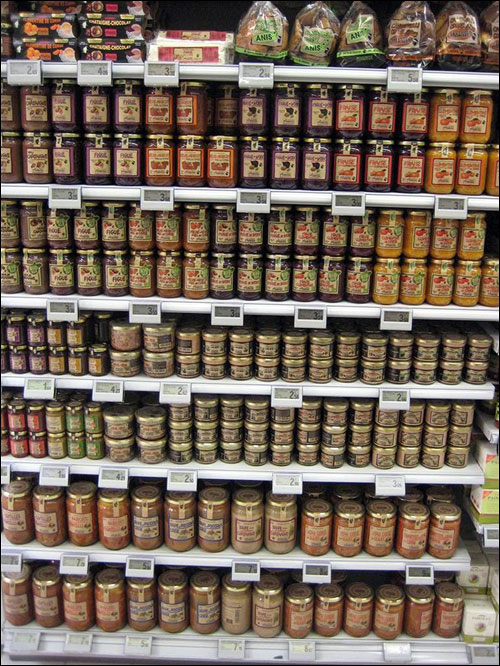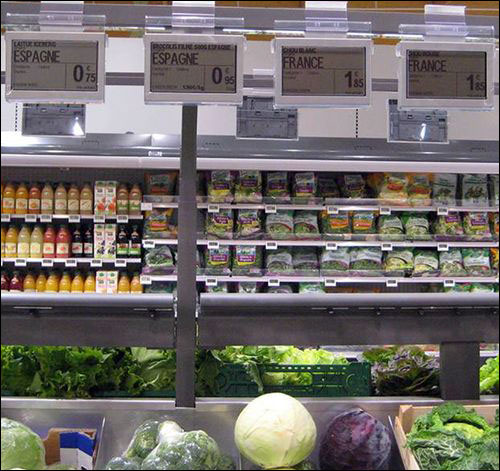Jun 15, 2012When prices are updated at the E.Leclerc supermarket in Saint-Jean-du-Falga, France, as many as 30,000 labels can change automatically, bringing an end to a time-consuming process by which staff previously had to manually print and swap out printed labels on store shelves.
In March 2012, the Saint-Jean-du-Falga store installed the Electronic Shelf Labeling (ESL) system, which employs radio frequency identification (RFID) to communicate pricing information to the labels. With the system in place, says Patrick Sobraquès, the store's owner and the president of E.Leclerc's IT Infomil subsidiary, "We don't need to have employees update the prices in the store at all anymore." This, he says, provides a significant cost savings for the store, though the exact amount of savings has yet to be measured.
Click here to view a larger version of the above diagram.
The RFID-enabled electronic labels, along with readers (access points), software for the read data, and integration services, were provided by Altierre, a technology firm based in San Jose, Calif., while the software linking the read data from Altierre's hosted server to E.Leclerc's back-end management system was supplied by Infomil.
Sobraquès says he first met with Altierre to investigate a possible ESL solution that would enable the store to update prices easily (the store's prices may change daily, based on sales and promotions). Without an electronic system, he explains, the store needed to have its staff make those changes manually, which was a very time-consuming process in the approximately 5,000-square-meter (53,800-square-foot) store. The retailer needed price labels for 30,000 different products—including some stored in refrigerators or freezers, in which case the labels would be located within the coolers themselves. Thus, the store required a solution in which the active RFID tags could operate at -20 degree Celsius (-4 degrees Fahrenheit).
Each tag's integrated circuit stores not only a unique identifier for the tag, but also pricing information and any other content that may appear on the LCD display. That could include animated images and text that may flash intermittently. In addition, says Sunit Saxena, Altierre's chairman and CEO, the tag contains an internal clock and can store information regarding future pricing linked to specific dates and times, thereby enabling the change of data on the screen—even if there is no transmission from a store reader, such as might be the case during a power outage.
When products are initially associated with a shelf label, staff members utilize a handheld device to scan a product's bar code, as well the ESL's bar-coded ID number (which matches the shelf label's RFID number), and to forward that association via a Wi-Fi connection to the store's back-end system, using Infomil software. The store's managers set pricing plans in the back-end software, and those prices are sent to the access points via an Ethernet cable—which, in turn, transmit the new information to the appropriate shelf labels. The labels, which are set to both transmit and receive data, capture the pricing information from the access points, and then store that data, displaying it on the LCD screen. They also send an acknowledgement transmission to the access points, indicating that the pricing transmission was received. If the tag does not return a response, the access point can forward that incident to the back-end software, thus indicating that a label may have been damaged or stolen, or may have failed. "We can supervise our tags... and make sure to have 100 percent success, thanks to the failures report," Sobraquès states. "So far, the system is working just fine."
In addition to offering electronic shelf labels, Altierre produces RFID-enabled temperature sensors designed to help retailers track the operation of refrigerators, freezers and hot-food display cases within their stores (see Altierre Sees Opportunity for Temperature Tags). In the future, Sobraquès reports, the store intends to add Altierre temperature sensors to the wireless platform that would enable its managers to receive an alert in the event that any of the store's coolers fall outside of an acceptable threshold, thereby indicating either a failure in the device or a door left ajar.
The labels themselves were designed by Altierre to be extremely robust, Saxena says, allowing them to operate under cold conditions, such as those found in a freezer. He says they have been effective at receiving and sending transmissions from extremely low temperatures through freezer or refrigerator doors.
The E.Leclerc chain of independently operated stores comprises one of the largest mass-market retailers in France, with 550 stores around the country, as well as more than 100 locations abroad, including in Spain, Portugal, Poland, Italy and Slovenia. Saxena and Sobraquès both decline to comment regarding whether there are any plans to install this solution at other E.Leclerc stores.





